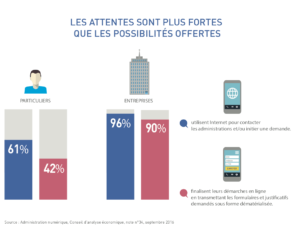Digital technology is everywhere in our daily lives. Public service users naturally expect the same quality of digital relationship and e-administration with the State as with local authorities.
They want to interact with the administration as easily as buying a train ticket. Log on to a family account to pay for canteen meals, or to a digital work environment to check their youngest child’s homework, or to chat with teachers. All this is becoming the norm.
More than just a collection of new technologies, the digital revolution is a transformation that affects all aspects of society. It poses three challenges for communities:
- The first concerns the sovereignty of public action and decision-making autonomy. These could be called into question both by the technologies themselves and by changes in usage.
- The second challenge is to ensure that everyone has access to digital technology and the ability to use it, so as not to exacerbate a societal divide that is already perceptible in some départements.
- Finally, the influence of the commercial uses of technology, which could tip public services into a new logic.
Reinventing the citizen-administration relationship.
As a result, the relationship between citizen and administration has changed completely over the last five years.
This change is based on several facts.
- Digital transformation, of course. Faced with ultra-connected users who turn to their mobiles with precise intentions and expect quick and simple answers
- Back to meaning. Users are looking for authenticity, a return to basics, inspiration, and therefore services that make sense.
- Personalization. Users need personalization, proximity. To be understood and listened to in an era of one-size-fits-all answers.
Thus, agility, sharing, contribution, autonomy, encounters and digital seem to oppose rigidity, isolation, planning and politics. Local authorities need to take the offensive on user experience to get closer to their citizens. Citizens who expect personalized, local service. And this, beyond the boundaries of different administrative perimeters. Local authorities must play the game and enter into a conversation with a “customer” citizen, rather than a “user” citizen. They need to engage in a real conversation around satisfying the request, freeing themselves from administrative formalism.
What is the key to successful digital transformation for local authorities?
The key is innovation at every level.
Technological, experiential and conversational.
Tomorrow’s main area of innovation concerns the combination of data and artificial intelligence. This combination will create a whole new wealth of services. A wealth that will make daily life and even quality of life easier for users.
Look at Chatbots, these intelligent conversational virtual agents available 24/7. With advances in the use of artificial intelligence, they will be able to provide truly contextualized and individualized responses. They’ll be able to respond intelligently to someone who’s wondering about his or her pension, or about a particular administrative event.
At that moment, communities will be in a real position to change the lives of their citizens!
We mustn’t forget that when citizens engage in a conversation with their local authority, they do so first and foremost with its staff and elected representatives, with whom they hope to have a personal relationship.
It is in this expectation that we must look for the roots of the demand for proximity and personalization. Any distancing, any undifferentiated treatment, is interpreted not rationally, but emotionally, as a lack of interest.





